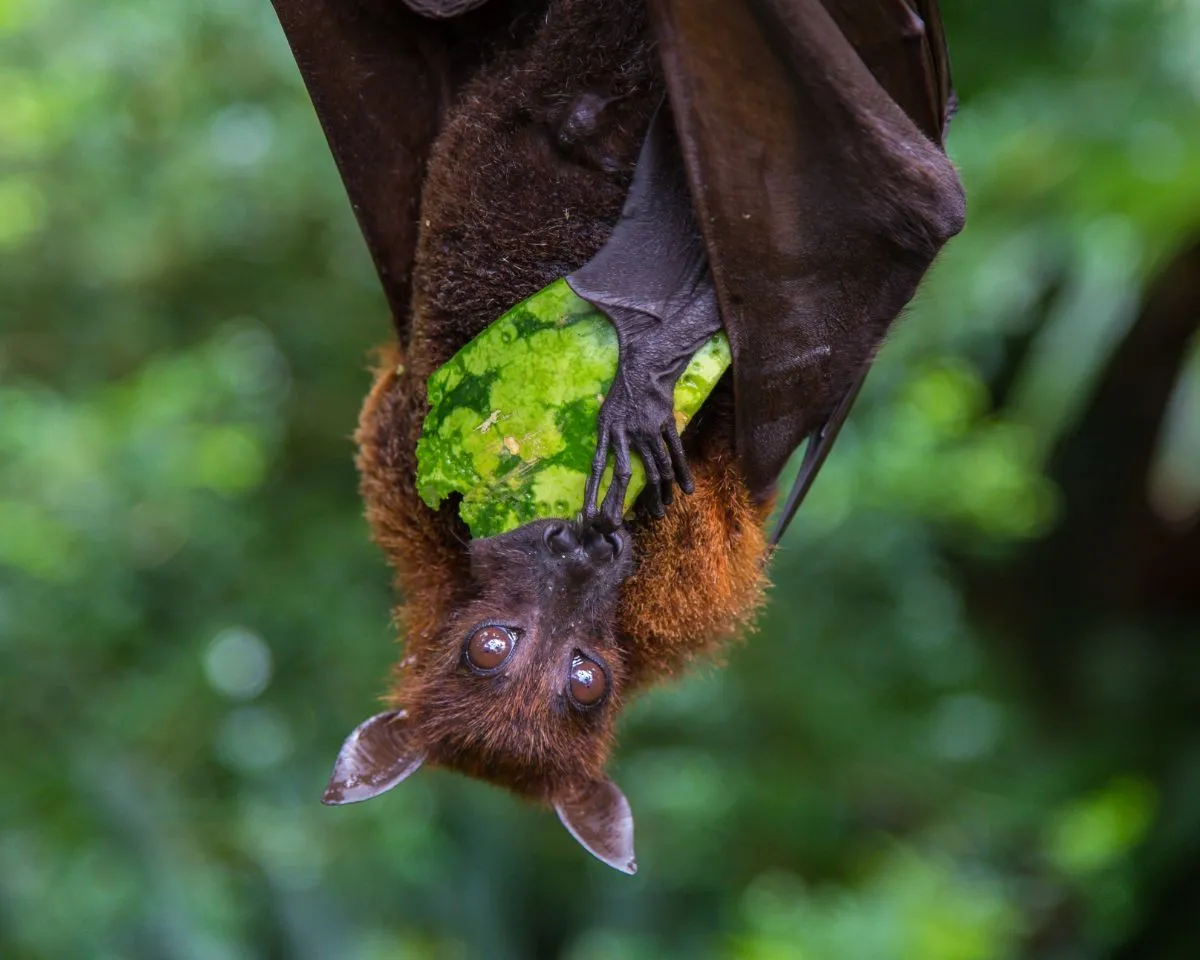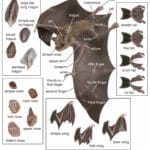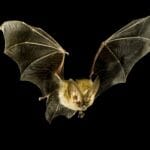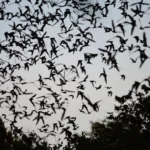Step into the captivating world of bats, where their dietary habits unlock a fascinating tale. As a seasoned wildlife veterinarian with a decade-long passion for these creatures, I’m eager to guide you through their unique feeding strategies. From the tiniest insects to remarkable adaptations, this journey will reveal the culinary secrets that make bats such intriguing members of our planet’s ecosystem. Dive into the fascinating world of bat diets and nutrition, and discover the hidden wonders within.
What’s on the Menu for Bats?
Bats aren’t just the spooky creatures you see in movies; they’re fascinating animals with unique eating habits. From tiny insects to juicy fruits, let’s dive into the diverse world of bat diets.
Insect-Eating Honchos
Most bats in North America are like the ninja assassins of the insect kingdom. They fly around, using their special sonar skills to find and snatch up mosquitoes, beetles, and moths. It’s like a midnight buffet for these hungry predators.
Nectar-Sipping Sweethearts
Not all bats are bloodthirsty creatures. Some, like the long-nosed bat, have a sweet tooth for nectar. They sip on this sugary goodness from flowers, and in return, they do their part to help pollinate plants.
Fruit-Loving Vegetarians
You might not think of bats as vegetarians, but some species, like the Jamaican fruit bat, have gone vegan. They chow down on fruits and berries, which must taste like candy to their fruit-loving palates.
Carnivorous Thrill-Seekers
A small group of bats, like the vampire bat and ghost bat, have a taste for meat. Their specially designed teeth and skills make them the top predators of the bat world, targeting small mammals and birds.
A Culinary Tapestry as Diverse as Their Species
Just like us humans have different tastes, different species of bats have different dietary preferences. From insect-munching insectivores to sweet-toothed pollinators and even carnivorous predators, bats’ diets are as varied and fascinating as the creatures themselves. So, there you have it, a peek into the bat’s dietary world. From the tiniest insects to the juiciest fruits, bats’ menus are a testament to nature’s amazing diversity.
Discover the fascinating collective noun for bats and delve into the unique characteristics of these nocturnal creatures. Dive into what a flock of bats is called and explore their social behavior. Uncover the secrets of a bat’s lifespan and unravel the mysteries of their longevity in the animal kingdom.
How do different bat species utilize echolocation to locate and capture prey?
Bats have a built-in radar called echolocation that helps them navigate and find their dinner in the dark. Echolocation is like playing sonar tag with your surroundings. Bats send out high-pitched noises that bounce off everything and come back to them as echoes. Their super-sensitive hearing can pick up these echoes and turn them into a mental map of the area, showing them where the food is and how to avoid crashing into things.
Different bat species are like different flavors of ice cream, each with its own unique take on echolocation. Horseshoe bats have a special “horseshoe” thing on their nose that helps them focus their echolocation like a laser pointer, so they can pinpoint their prey with incredible accuracy.
Other bats, like the pallid bat, have echolocation that’s like a moth magnet. Their calls are tuned to the perfect frequency to attract those tasty insects. It’s like leaving a trail of breadcrumbs leading straight to their mouths!
Thanks to echolocation, bats have become the ninjas of the night sky. They can detect their prey in the pitch black, giving them a serious advantage in the bug-catching game. It’s like having built-in night vision goggles and a GPS all rolled into one amazing package.
Key Takeaways:
- Echolocation is like a bat’s built-in GPS and radar, helping them find food and avoid danger.
- Different bat species have special adaptations, like big ears and sensitive hearing, that make their echolocation even better.
- Some bats can use echolocation to focus on specific prey, like a bat-sized sniper.
What are the nutritional requirements of bats and how do their diets meet these needs?
Bats, with their wide array of species, have unique nutritional requirements that match their diverse diets. But let’s focus on insectivorous bats, masters of insect-hunting. How do their diets satisfy their nutritional demands? Let’s explore their secret formula!
Nutritional Needs of Insectivorous Bats
Picture a bat as a tiny powerhouse. To sustain their energetic lifestyle, they need plenty of protein. Insects are like tiny protein-packed treats that keep these aerial acrobats fueled. But it’s not just protein; they also crave fat, the energy booster that helps them soar through the night.
And just like humans, bats can’t go without their vitamins and minerals. Calcium is essential for strong bones, and vitamin A keeps their vision sharp. These nutrients are like the secret weapons that keep bats flying and hunting in top form.
Insect-Eating Adaptations
Insectivorous bats haven’t just settled for eating insects; they’ve evolved to be insect-catching machines! Their echolocation skills are like superhero hearing, allowing them to pinpoint prey with laser-like precision. Their razor-sharp teeth are perfect for grabbing and munching on these tiny critters.
But what’s really impressive is their superpower metabolism. It’s like a high-speed engine that lets them digest and absorb nutrients from their insect meals lightning fast. So, even though insects are small, bats can quickly refuel and get back to hunting.
Caring for Captive Insectivorous Bats
If you ever meet a bat in captivity, you’ll probably see them enjoying their daily feast of live mealworms. This insect delicacy is the main course in their captive diet. But to keep them healthy and happy, zookeepers also add special supplements to their menu. These supplements provide the essential vitamins, minerals, and fatty acids that bats need to thrive.
Key Takeaways:
- Different bat species have different nutritional needs based on their diets.
- Insectivorous bats need lots of protein, fat, vitamins, and minerals.
- Echolocation, sharp teeth, and high metabolism are the secret weapons that help insectivorous bats catch and digest insects.
- Captive insectivorous bats are fed mealworms and supplements to meet their nutritional requirements.
So, there you have it, the nutritional secrets of our nocturnal friends. By understanding their special dietary needs, we can better appreciate these amazing creatures and the unique adaptations that make them such fascinating parts of our ecosystem.
How does the diet of bats impact their overall health and ecology?
Get ready to dive into the fascinating world of bats and their extraordinary eating habits!
Bats are just like us, they need a balanced diet to stay healthy and active. But guess what? They have a wider range of food choices than we do! From the tiny bugs they scoop up in their mouths to the sweet nectar they slurp from flowers, bats eat a variety of things that have a big impact on their overall well-being and the environment around them.
Fueling Their Superpowers
Insectivorous bats, like the little brown bat, are like tiny superheroes patrolling the night sky. They chow down on tons of insects, helping us out by controlling pests that can munch on our crops and spread diseases. These flying bug-eaters need loads of protein and energy to keep up with their fast-paced lifestyle and high metabolism.
Fruit Fanatics
Flying foxes, on the other hand, have a sweet tooth for fruits. They love to share the fruits of their labor, playing a key role in dispersing seeds and helping forests grow big and strong. These frugivorous bats are all about the carbs, which give them the energy they need to flutter around all night long.
Special Adaptations
Bats have adapted to their diverse diets over millions of years. Vampire bats, for example, have extra-sharp teeth and special stuff in their saliva that keeps the blood flowing when they munch on their meal. Nectar-feeding bats, with their long, lanky tongues and brush-like tips, are the perfect straws for sipping nectar from flowers.
Key Points to Remember:
- Bats have a wide range of tasty choices, from insects to fruits and even blood.
- What they eat affects their health, happiness, and overall awesomeness.
- Bats are like tiny superheroes in the ecosystem, helping to spread seeds, control pests, and pollinate plants.
- Over time, bats have developed special adaptations to match their special diets.
So, there you have it! The diet of bats is a major player in their well-being and the balance of nature. It’s like a delicious recipe that keeps the world of bats flying high and healthy.
FAQ
Q1: What is the primary diet of most bats in North America?
A1: Most bats in North America are insectivores, consuming flying insects like mosquitoes and beetles.
Q2: Do all bats consume insects?
A2: No, while many bats are insectivores, there are also species that feed on nectar, fruit, pollen, vertebrates, and even blood.
Q3: How do bats use echolocation to find food?
A3: Bats emit high-frequency sound waves and interpret the returning echoes to create a spatial representation of their surroundings, enabling them to navigate and locate prey in complete darkness.
Q4: How much food do bats consume daily?
A4: Adult bats typically consume 10-15% of their body weight daily to maintain their high metabolic rate.
Q5: What is the nutritional composition of the diet of captive insectivorous bats?
A5: Captive insectivorous bats are primarily fed live mealworms and supplemented with vitamins, minerals, and fatty acids to ensure optimal health and nutrition.
- Unlocking Francis Alexander Shields’ Finance Empire: A Comprehensive Biography - July 12, 2025
- Unveiling Francis Alexander Shields: A Business Legacy - July 12, 2025
- Francis Alexander Shields’ Business Career: A Comprehensive Overview - July 12, 2025















